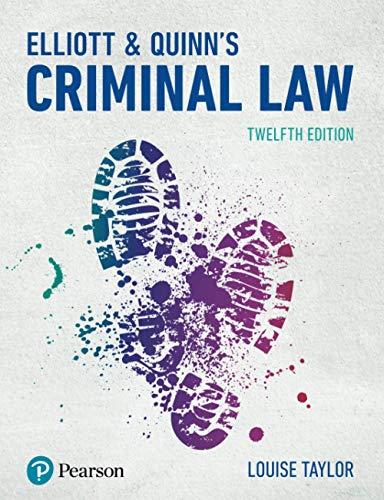Answered step by step
Verified Expert Solution
Question
1 Approved Answer
Week 5 Reading Guide LAW211 Business Law I Chapters 9, 10, 11 Each question is valued at 1 point unless otherwise indicated. Questions should be
Week 5 Reading Guide LAW211 Business Law I Chapters 9, 10, 11 Each question is valued at 1 point unless otherwise indicated. Questions should be answered in full sentences; enough detail should be provided to distinguish terms and examples should be given when possible. Higher-valued questions should be answered in more detail than lower-valued questions. 1. Define the following terms related to contracts: valid, void, voidable and unenforceable. 2. Define the term Quasi Contract. 3. Identify and define the four elements of a valid contract. (2 points) 4. Distinguish an express and an implied contract. 5. Define the terms "promisor", "promisee," "offeror," and "offeree" (2 points) 6. Distinguish an executed and an executory contract. 7. What is the scope of Article 2 of the Uniform Commercial Code and how does that scope differ from state common law? (2 points) 8. Define a contract. To be enforceable, must a contract be in writing? (2 points) 9. Distinguish an option contract and a firm offer. 10. What is meant by mutual assent? How do the parties normally show this assent? (2 points) 11. Distinguish revocation and rejection. 12. Define the "mailbox rule" and how it affects the formation of a contract. (2 points) 13. To be effective an offer must be what? 14. Generally speaking, when can an offer be withdrawn? 15. What effect does a defective acceptance have on the offer? 16. What effect does each of the following have on a contract: (1) the death of either the offeror or offeree; (2) the failure of the subject matter; (3) a change in the law? (3 points) 17. If you do not know of the offer, can you accept the offer? 18. How can an offer be communicated? 19. Distinguish an output contract and a requirements contract. 20. Generally, when is an acceptance effective? What about an offer? 21. What is meant by a reasonable period of time when it comes to an offer? 22. What is the "mirror image rule?" What is the result of its application? (2 points) 23. What is a Counteroffer? 24. When is misrepresentation of a fact material? 25. What is the effect on a contract if one of the parties to the contract signs the contract without first reading it? 26. What are the elements of fraud? 27. What is the difference between a mutual mistake and a unilateral mistake? 28. What is scienter? How is it relevant to the concepts of fraud and nonfraudulent misrepresentation? 29. What is the difference between fraud in the execution and fraud in the inducement? What is the effect of each on a contract? 30. Define the term duress and identify the two types of duress. What effect does duress have on a contract? (2 points)
Step by Step Solution
There are 3 Steps involved in it
Step: 1

Get Instant Access to Expert-Tailored Solutions
See step-by-step solutions with expert insights and AI powered tools for academic success
Step: 2

Step: 3

Ace Your Homework with AI
Get the answers you need in no time with our AI-driven, step-by-step assistance
Get Started


